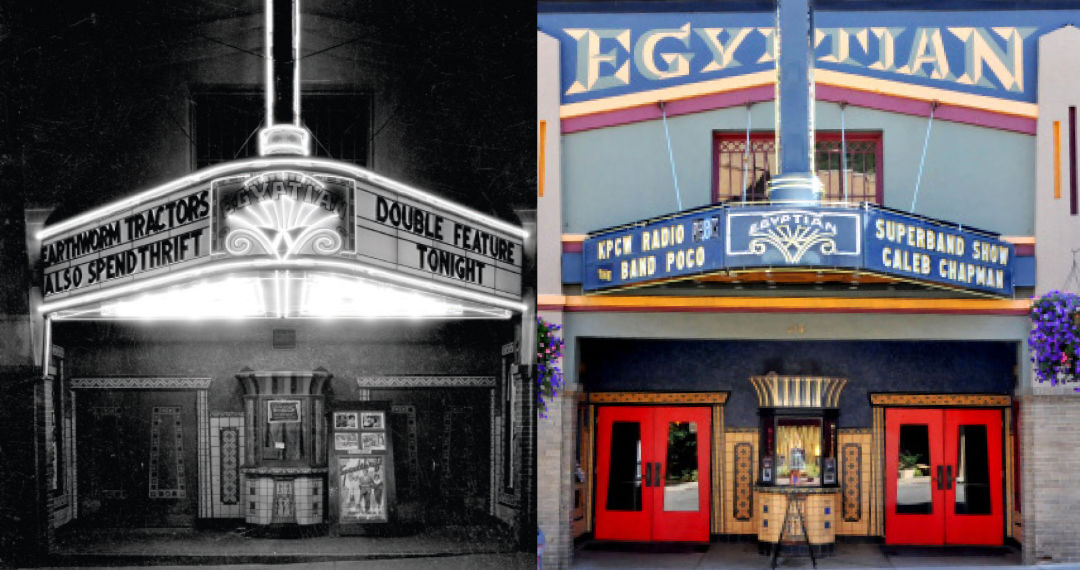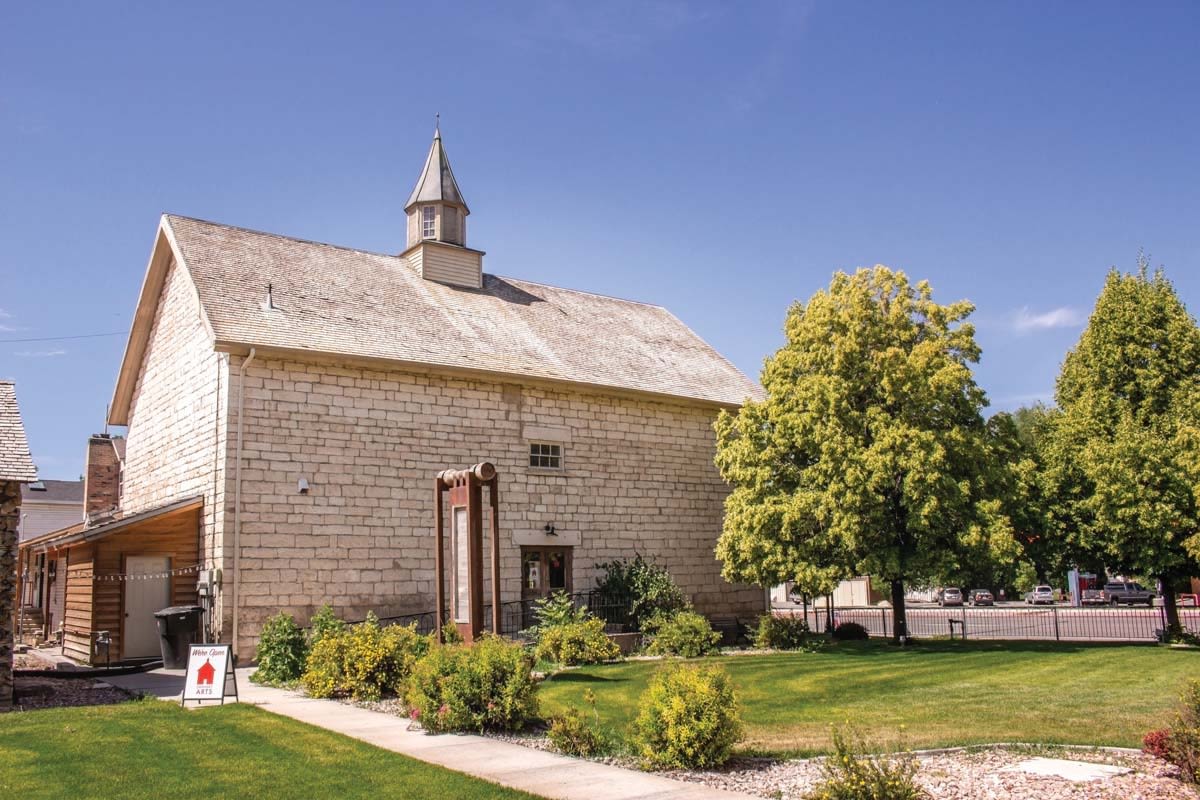Staging a Comeback

Image: Park City Museum and Egyptian Theater
As you step off of Park City’s busy Main Street and through the Egyptian Theatre doorway, you enter a different world. Sphinx-like drawings and Cleopatra-lined eyes grace the walls; the small lobby gets humid as it fills with patrons; a tiny concession stand is squeezed in the corner. Inside the theater itself, the atmosphere remains intimate, with sloping floors and dark walls that draw the audience’s focus to the stage, bordered by faux stones and hieroglyphics that convey a sense of prominence. When the lights go down, you’ll feel immersed in a comfortable cocoon, ready to be spirited away on an unforeseen adventure.
The history of our local theater building has been an adventure in itself. Back-breaking labor by day did not hamper early Park City miners’ love of entertainment by night: eking by on wages of barely $2 a day in the late 1800s, the miners still managed to raise approximately $30,000 via ticket subscriptions to help build an ornate Opera House on Main Street. The performance venue promised a welcome escape from the dark and dangerous working conditions in town at the time, but sadly the Opera House was destroyed by Park City’s Great Fire of 1898 just three months after opening.
The Dewey Theatre was built a few doors down from the Opera House site as a cultural center, playing host to ballroom dancing, prize fighting, live theater, and even a bowling alley. But especially heavy snowfall in 1916 caused the Dewey’s roof to collapse, mere hours after a performance attended by a large crowd had ended. The theater was totally destroyed.
Undaunted by bad luck and the elements, Parkites began construction on the current Egyptian Theatre in 1922. The architecture, adorned with lotus-leaf motifs, scarabs, hieroglyphics, and Egyptian symbols of life and happiness, was heavily influenced by the discovery that year of King Tutankhamen’s tomb. The theater opened on Christmas Eve 1926 as a cinema house and saloon that also featured traveling vaudeville acts.
Since its opening, the Egyptian has gone through several name and ownership changes, and it has been at death’s door more than once. When the once-proud building found itself requiring major renovations in 1978, a group of theater-loving locals pain-stakingly raised funds for restoration. But by the 1990s, the building was again in dire need of help. Local resident Rick Rogers, whose maternal grandmother, Mary Steiner, had instilled in him a love of the theater at an early age, joined forces with fellow local JoAnn Krajeski and others to form Save Our Stage. The group’s tireless fundraising efforts returned the theater, renamed the Mary G. Steiner Egyptian Theatre, to its former glory.

Clockwise from left: The Dewey Theatre, the show Gypsy, Sundance Film Festival
Image: Park City Museum and Egyptian Theater
Even with a renovated building, local theater here has remained fraught with financial pitfalls. The cost to put on a show in a small venue like the Egyptian (which seats 266) can’t be covered by ticket sales alone. Partly as a result of the recent economic downturn, debt began to build, and sponsors and donors became scarce. At a heartbreakingly low point in 2009, the Egyptian’s board of directors was forced to cut staff, terminate Equity status (which had allowed the hiring of professional casts and crews), and cancel the 2009 season.
“Hardworking theaters operate out of pure love of a good show,” says Randy Barton, the Egyptian’s manager and director. “Finances are a daily concern, but you forge ahead, using whatever meager resources you have. You hope for an appreciative audience and sold-out shows.”
Thankfully, in the past year the theater has again risen from the ashes. The board has reevaluated its mission and made it a home for multiple uses, including in-house productions, music, comedy, film, and civic events. This past year, events included musicals such as The Fantasticks, Hair, and Gypsy; dance performances such as Thriller and Park City Burlesque; comedy nights; intimate concerts with the likes of Leo Kottke and Judy Collins; and more. Another annual hit (no local misses this one) is Egyptian’s Park City Follies, an end-of-ski-season spoof incorporating a volunteer cast of writers and actors poking fun at life in Park City.
Chris Aall, past president of the Egyptian’s board of directors, credits a few other key factors in bringing the theater to a sounder financial footing. “We decided to stage only events that had been fully underwritten in advance,” he says. “That way, ticket sales pay for overhead, retire debt, and fund capital expenditures. The creation of the Pharaoh Club [an elite-tier theater membership group] also integrates patrons more closely with us, giving them greater benefits and the theater tremendous support in consistent revenue.” The theater has also raised funds by renting out its vast collection of costumes.Thankfully, in the past year the theater has again risen from the ashes. The board has reevaluated its mission and made it a home for multiple uses, including in-house productions, music, comedy, film, and civic events. This past year, events included musicals such as The Fantasticks, Hair, and Gypsy; dance performances such as Thriller and Park City Burlesque; comedy nights; intimate concerts with the likes of Leo Kottke and Judy Collins; and more. Another annual hit (no local misses this one) is Egyptian’s Park City Follies, an end-of-ski-season spoof incorporating a volunteer cast of writers and actors poking fun at life in Park City.
These changes have contributed to a sense of optimism and possibility for this proud Park City landmark. The iconic marquee continues to receive international exposure in publicity photos for the Sundance Film Festival, and the theater itself serves as a venue for showcasing Sundance films. But the real impact of the Egyptian lies in its role as a gathering point for the community, no matter the season.
“For the first time ever, we have live entertainment on stage every weekend of the year,” Barton exults. Let the show go on!
Terry Moffitt has enjoyed being on stage, behind the scenes, and in the audience at the Egyptian Theatre.

































